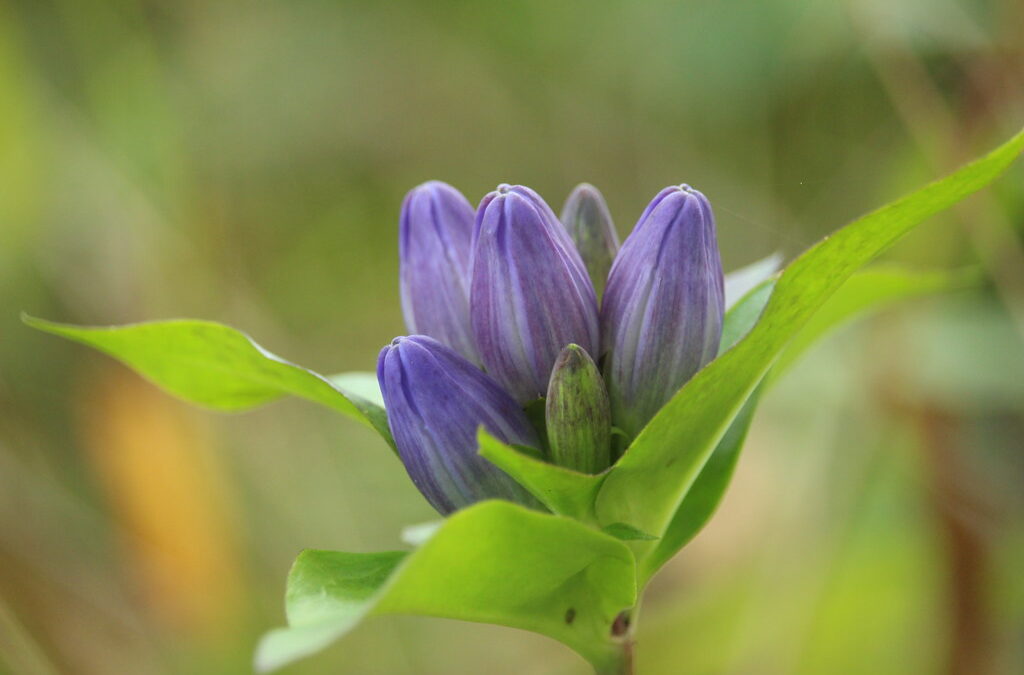By Sarah Hatfield
“Oh! That’s Closed Gentian! I haven’t seen that in years.”
I was at a workshop recently, and there were four of us taking our time and walking at the back of the group, which was already fifty feet ahead of us. The session was focused on wildlife habitat improvement. The speakers were doing a great job sharing the lead, addressing both the perspective of those who wanted to improve lots to attract game and those wanting to attract all wildlife.
Because we were slower, we had time to notice more. In the ditch along the edge of the access road, I spied the wildflower that led to my exclamation. Much of it had been nibbled by the deer (the landowner’s food plots were definitely attractive!) but there were 3 or 4 stems left with blooms. When I say blooms, I mean something that looks like a flower bud, because this flower never truly opens. Hence its name, ‘Closed’ Bottle Gentian.
Have you ever seen it? The flower is an indigo purple that can look blue in certain light. Its leaves look sharp and pointy, but aren’t. It likes wet feet and grows about 1 – 2 feet tall. In general, it is unremarkable to the eye. My curious mind finds it very interesting. Because the flower never opens, only large bees, like bumblebees, can pollinate it. It is such a specialized plant, I could only wonder how it ended up looking like that.

But I digress, because what I really want to share was the genuine curiosity that my exclamation elicited from my companions. To the three people with me, I pointed it out, gave a bit of its history and ecology, and let observation take over. One said “I think I’ve seen that before, down by the pond.” Another asked if it was from around here.
Later, one of the curious minds asked for the name of it again, and I wrote it down for him. Honestly, if that’s all that happened that day, it would have been a good day. Because the most valuable thing about workshops like this is the connections between people, the sharing of what we know, and the stories of the land and nature that weave them together.
See, adults are funny when you put them in a ‘learning’ setting — they don’t shout out answers to questions like kids, they don’t ask questions when they have them, and they rarely react to the instructor to give them an indication of how the presentation is going (no smiles, laughter, bored looks, fidgeting, etc.). It is hard to teach adults in a class setting, even when that class is in the middle of the field.
But a casual group? They will talk and inquire and exclaim and learn and share their knowledge readily. I got the opportunity to share a wildflower with them, a very cool one, that hopefully they remember a bit about if not its name. I learned how one person cultivates her raised beds in a no-till method to maintain soil health in a side conversation. I heard how one man prepped his plot for wildflowers with mechanical methods, not the herbicide technique.
That was the amazing part of the day, to see adults sharing their knowledge. As much information was shared between people in breaks before and after sessions as in them. As much was learned at lunch in conversation as in the handouts. What brought all these folks together? A conservation mindset and the desire to improve their land. Old friends got to visit, a former student got to visit with their former high school teacher, now sharing information as like-minded landowners wanting to attract pollinators. Talking to someone who has tried something is better than any knowledge from a book. This knowledge was earned from mistakes that were corrected and tried again. That knowledge is priceless.

That this group of people who came together on a farm in Youngsville on a very brisk and breezy day is proof that the natural landscapes can unite diverse groups with common goals. The natural world has so many catalysts for relationship-building — recreation, hunting, growing food, trees, birds, or a strange, medium-sized flower that never opens and relies on one particular kind of insect to proliferate. Think about how you’ve met some of the people in your life, does nature play a part in any of them?
Would I have sought out the company of strangers to discuss their conservation strategies, hopes, successes, and failures? Anyone who knows me even a little bit knows the answer to that is an emphatic ‘no;’ I’ll never seek out a group of people for any reason, introvert that I am. Did I enjoy my time with that group? Certainly. I met some new people who want to make the world a better place from an ecological standpoint. I learned a lot. I am still thinking about a lot of it.
Are we all going to conserve our land the same way with the same methods? Nope, every situation is different as is each parcel and person. But conservation was the common thread woven between the farmers and friends, landowners and horticulturists that gathered together. Knowledge shared is power. In this case, it is the power to improve the land that supports us all. Even if the knowledge is as small as a purple flower that never quite opens.
Audubon Community Nature Center builds and nurtures connections between people and nature. ACNC is located just east of Route 62 between Warren and Jamestown. The trails are open from dawn to dusk as is Liberty, the Bald Eagle. The Nature Center is open from 10 a.m. until 4:30 p.m. daily except Sunday when it opens at 1 p.m. More information can be found online at auduboncnc.org or by calling (716) 569-2345.
Sarah Hatfield is Education Coordinator at ACNC.


Recent Comments